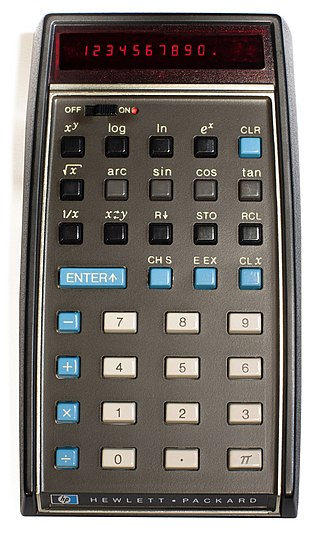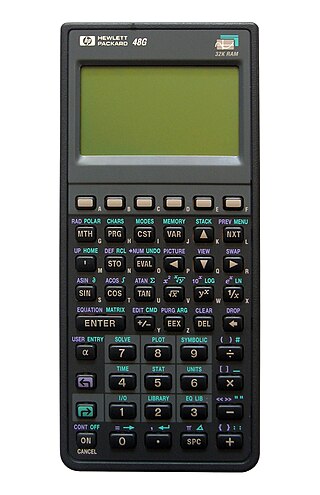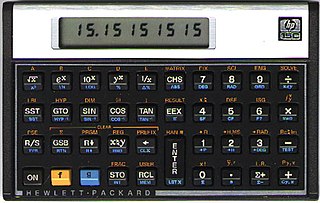
A scientific calculator is an electronic calculator, either desktop or handheld, designed to perform calculations using basic and complex mathematical operations and functions. They have completely replaced slide rules and are used in both educational and professional settings.

The HP-35 was Hewlett-Packard's first pocket calculator and the world's first scientific pocket calculator: a calculator with trigonometric and exponential functions. It was introduced in 1972.

The HP-65 is the first magnetic card-programmable handheld calculator. Introduced by Hewlett-Packard in 1974 at an MSRP of $795, it featured nine storage registers and room for 100 keystroke instructions. It also included a magnetic card reader/writer to save and load programs. Like all Hewlett-Packard calculators of the era and most since, the HP-65 used Reverse Polish Notation (RPN) and a four-level automatic operand stack.

The HP 33s (F2216A) was a scientific calculator marketed by Hewlett-Packard. It was introduced in 2003 as the successor to the HP 32SII, and discontinued on the introduction of its successor the HP 35s in 2007.

The HP-20S (F1890A) is an algebraic programmable scientific calculator produced by Hewlett-Packard from 1987 to 2000.

The HP-42S RPN Scientific is a programmable RPN Scientific hand held calculator introduced by Hewlett-Packard in 1988. It has advanced functions suitable for applications in mathematics, linear algebra, statistical analysis, computer science and others.

The HP-27S was a pocket calculator produced by Hewlett-Packard, introduced in 1988, and discontinued between 1990 and 1993. It was the first HP scientific calculator to use algebraic entry instead of RPN, and though it was labelled scientific, it also included features associated with specialized business calculators.
Engineering notation or engineering form (also technical notation) is a version of scientific notation in which the exponent of ten is always selected to be divisible by three to match the common metric prefixes, i.e. scientific notation that aligns with powers of a thousand, for example, 531×103 instead of 5.31×105 (but on calculator displays written without the ×10 to save space). As an alternative to writing powers of 10, SI prefixes can be used, which also usually provide steps of a factor of a thousand. On most calculators, engineering notation is called "ENG" mode as scientific notation is denoted SCI.

The HP-32S was a programmable RPN Scientific Calculator introduced by Hewlett-Packard in 1988 and discontinued in 1991. It continued the tradition of the HP-15C programmable RPN Scientific Calculator. But some functions of the HP-15C were omitted and some were reduced in functionality, so to some extent it is more correct to say that the HP-32S expanded upon the HP-34C. It supported complex math, statistics, probability, and other functions.

HP calculators are various calculators manufactured by the Hewlett-Packard company over the years.
There are various ways in which calculators interpret keystrokes. These can be categorized into two main types:

The Hewlett-Packard Voyager series of calculators were introduced by Hewlett-Packard in 1981. All members of this series are programmable, use Reverse Polish Notation, and feature continuous memory. Nearly identical in appearance, each model provided different capabilities and was aimed at different user markets.

The HP-15C is a high-end scientific programmable calculator of Hewlett-Packard's Voyager series produced between 1982 and 1989.

The HP-28C and HP-28S were two graphing calculators produced by Hewlett-Packard from 1986 to 1992. The HP-28C was the first handheld calculator capable of solving equations symbolically. They were replaced by the HP 48 series of calculators, which grew from the menu-driven RPL programming language interface first introduced in these HP-28 series.

The HP-34C continuous memory calculator was an advanced scientific programmable calculator of the HP 30 series. It was produced between 1979 and 1983.

The Texas Instruments Business Analyst series is a product line of financial calculators introduced in 1976. BA calculators provide time value of money functions and are widely used in accounting and other financial applications. Though originally designed specifically for financial use, current models also include basic scientific calculator and statistics functions. The BA series competes directly with other mid- to high-end financial calculators, particularly the HP-12C and other models from TI competitor Hewlett-Packard. There are two models in the product line: the BA II Plus and the BA II Plus Professional.

The HP 35s (F2215A) is a Hewlett-Packard non-graphing programmable scientific calculator. Although it is a successor to the HP 33s, it was introduced to commemorate the 35th anniversary of the HP-35, Hewlett-Packard's first pocket calculator. HP also released a limited production anniversary edition with shiny black overlay and engraving "Celebrating 35 years".

The HP 20b Business Consultant is a financial calculator published in 2008 by Hewlett-Packard. Its function is similar to HP 10bII and includes scientific and statistical functions.

The HP-55 was a programmable handheld calculator, a lower-cost alternative to the HP-65. Introduced by Hewlett-Packard in 1975, it featured twenty storage registers and room for 49 keystroke instructions. Its outward appearance was similar to the HP-65, but its silver band went through between the display and the keyboard like HP-45, and the functions of some keys were different from HP-65, and it did not have a magnetic card reader/writer. Like all Hewlett-Packard calculators of the era and most since, the HP-55 used Reverse Polish Notation (RPN) and a four-level automatic operand stack.

The HP-21 was a scientific calculator produced by Hewlett-Packard between 1975 and 1978. It was designed as a replacement for the HP-35, and was one of a set of three calculators, the others being the HP-22 and HP-25, which were similarly built but aimed at different markets.


















